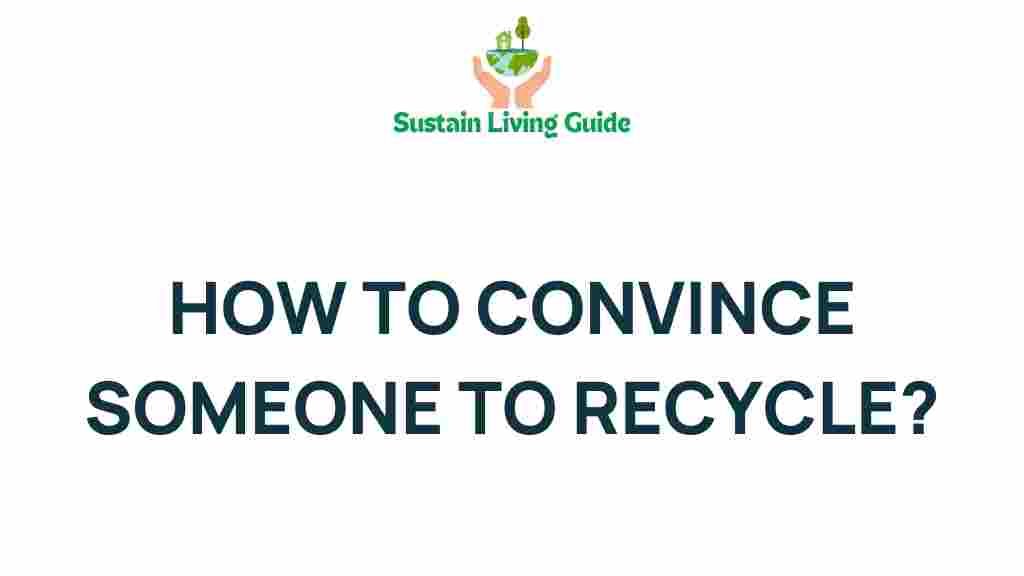Unlocking the Secrets: How to Persuade Others to Recycle
In an age where environmental awareness is paramount, the act of recycling has gained immense importance. However, despite the clear benefits of recycling, many individuals still struggle to embrace this practice. Understanding how to effectively persuade others to recycle can lead to significant improvements in waste management and environmental sustainability. In this article, we will explore various strategies to encourage recycling, highlighting key insights that can help you influence those around you.
Understanding the Importance of Recycling
Before diving into the methods of persuasion, it’s crucial to understand why recycling is necessary. Recycling not only conserves natural resources but also reduces pollution and energy consumption. Here are some compelling reasons to promote recycling:
- Conserves Resources: Recycling helps in conserving raw materials like timber, water, and minerals.
- Reduces Landfill Waste: By recycling, we decrease the amount of waste that ends up in landfills.
- Decreases Pollution: Recycling processes generally result in lower emissions of harmful pollutants.
- Saves Energy: Producing goods from recycled materials often consumes less energy compared to using new materials.
The Psychology of Persuasion
Understanding how people think and what motivates them can be instrumental in persuading them to recycle. The following psychological principles can be leveraged:
1. Social Proof
Humans are inherently social beings. They often look to others for cues on how to behave. By highlighting how many people are already recycling, you can encourage others to follow suit. Share statistics or stories about local recycling efforts that have made a difference.
2. Reciprocity
People are more likely to engage in a behavior if they feel they are receiving something in return. By providing incentives for recycling, such as rewards programs or community recognition, you can motivate others to participate.
3. Commitment and Consistency
Once individuals commit to a behavior, they are more likely to continue doing it. Encourage small commitments, like signing a pledge to recycle, which can lead to larger actions over time.
Step-by-Step Process to Persuade Others to Recycle
Now that we understand the psychology behind persuasion, let’s look at a structured approach to motivating others to recycle effectively:
Step 1: Educate
Knowledge is power. Start by educating your peers about the benefits of recycling. Consider the following methods:
- Host workshops or seminars on recycling.
- Distribute informative pamphlets or flyers.
- Utilize social media platforms to share facts and success stories.
Step 2: Make Recycling Easy
Removing barriers to recycling can significantly boost participation rates. Here’s how you can simplify the process:
- Ensure recycling bins are readily available in public spaces.
- Provide clear labeling on recycling bins to minimize confusion.
- Organize community clean-up days that include recycling efforts.
Step 3: Create a Supportive Environment
Encouraging a culture of recycling requires community buy-in. Foster an environment where recycling is the norm:
- Encourage local businesses to adopt recycling programs.
- Engage schools in recycling initiatives.
- Utilize local influencers to advocate for recycling in your community.
Step 4: Use Incentives
Offering rewards can be a powerful motivator. Consider these incentive ideas:
- Establish a points system for regular recyclers that can be exchanged for rewards.
- Highlight businesses or individuals who make significant contributions to recycling efforts.
- Run contests to promote friendly competition around recycling efforts.
Step 5: Follow Up
Once you’ve initiated your recycling campaign, it’s essential to maintain momentum. Regular follow-ups can help:
- Send reminders through newsletters or social media.
- Share updates on community recycling statistics to maintain interest.
- Solicit feedback to improve future recycling initiatives.
Troubleshooting Common Challenges in Recycling
While persuading others to recycle can be rewarding, you may encounter challenges. Here are some common obstacles and solutions:
1. Lack of Awareness
Many people simply don’t know how to recycle correctly. Combat this by:
- Providing clear, easy-to-understand recycling guidelines.
- Creating visual aids, like infographics, that simplify the recycling process.
2. Misconceptions About Recycling
Some individuals may have misconceptions about the effectiveness of recycling. Counter this by:
- Sharing success stories and statistics that highlight the positive impact of recycling.
- Engaging in conversations to address specific concerns and provide factual information.
3. Inconvenience
If recycling is perceived as inconvenient, individuals may avoid it. Address this by:
- Placing recycling bins in easily accessible locations.
- Offering pick-up services for recyclables in your community.
Conclusion
Persuading others to recycle is not merely about urging them to change their habits; it’s about creating a culture of sustainability that benefits everyone. By educating your community, making recycling easy, fostering a supportive environment, offering incentives, and troubleshooting challenges, you can effectively encourage others to embrace recycling. Remember, every small effort counts, and together, we can make a significant impact on our environment.
For more insights on promoting recycling in your community, check out this comprehensive guide. Additionally, visit the EPA’s recycling page for more resources and information.
This article is in the category Waste and created by SustainLivingGuide Team
